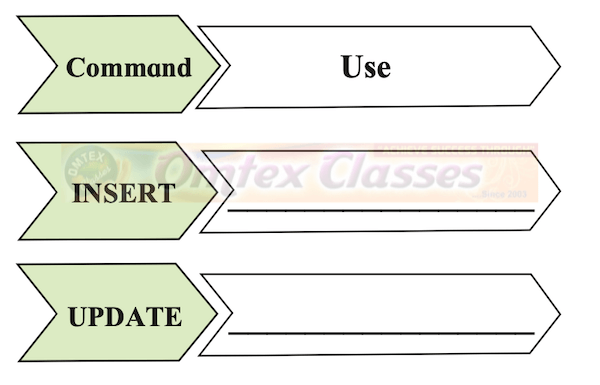Chapter 2: Introduction to DBMS
Tick whichever box is not valid.
OPTIONS
Graphic
Date
Number
Text
Student wants to create a field pincode in a table, which data type will he choose?
SOLUTION
INT
Tick the appropriate box.
OPTIONS
is also called foreign key
Uniquely identifies a record
Tick the appropriate circle.
OPTIONS
Only one record
Only single table
One or many tables
None of these
Observe the field names of a database given below in ‘Column A’ related to Bus reservation. Write suitable data types for each field in front of the respective field in ‘Column B’
SOLUTION
SOLUTION
SOLUTION
SOLUTION
Write the use of following SQL command
INSERT
SOLUTION
Insert data into a table
UPDATE
SOLUTION
Update data in a table
Create a table for the information given below by choosing appropriate data types. Specify proper primary key for the table 1) Movie 2) Actor
Movie (Registeration_no, movie_name, Realease_Date)
Actor (actor_id, Actor_name, birth_date )
SOLUTION
Create table movie (
Registration_no smallint primary key,
movie_name varchar (20),
Release_Date date
);
Create table actor (
actor_id smallint primary key,
Actor_name varchar (20),
birth_date date
);
Consider the following table Stationary. Write SQL commands for the following statement.
Write SQL command to create above Table
SOLUTION
Create table Stationary (
S_ID int primary key,
S_Name varchar (20),
C_Name varchar (20),
Price smallint,
Quantity smallint
);
Write SQL command to insert above mentioned record in table
SOLUTION
INSERT INTO Stationary values
(001, 'Note Book', 'ABC', 20, 50)
(002, 'Pencil Box', 'XYZ', 10, 80)
(003, 'A4 Pages rim', 'PQR', 600, 2);
To delete the above table.
SOLUTION
DROP table Stationary;
What is a database?
SOLUTION
A DBMS is a collection of programs (computer based system) that enables the user to create and maintain a database it is used to define, construct and manipulate the data in the database for various applications. It provides information storage, organization and retrieval capabilities. The DBMS also enforces necessary access restrictions and security measures in order to protect the database. Various types of control systems within the DBMS make sure that the database continues to function properly. They Include Integrity system Security system Concurrency control system Recovery control system Some DBMS enable us to define “views” of the database. A view is how the database appears to the user. This enables us to show only the relevant information to different types of users and it increases security, as certain users will not be able to see data which they are not meant to see.
What are the advantages of a DBMS?
SOLUTION
Redundancy is controlled: In File Processing System, duplicate data is created in many places because all the programs have their own files. This creates data redundancy which in turns wastes labor and space. 'In Database Management System, all the files are integrated in a single database. The whole data is stored only once at a single place so there is no chance of duplicate data.
Sharing of Data: In a database, the users of the database can share the data among themselves. There are various levels of authorization to access the data. And consequently the data can only be shared based on the correct authorization protocols being followed.
Data Security: Data Security is vital concept in a database. Only authorized users should be allowed to access the database and their identity should be authenticated using a username and password. Unauthorized users should not be allowed to access the database under any circumstances as it violates the integrity constraints.
Enforces integrity constraints: Constraints are used to store accurate data because there are many users who feed data in database. Data stored in database should always be correct and accurate. DBMS provides the capability to enforce these constraints on database.
Provides backup and recovery of data: Data loss is a very big problem for all the organizations. In traditional tile processing system, a user needs to backup the database after a regular interval of time that wastes lots of time and resources._If the volume of data is large then this process may take a very long time.
What do you understand by Data Model?
SOLUTION
A Database model defines the logical design and structure of a database and defines how data will be stored, accessed and updated in a database management system. While the Relational Model is the most widely used database model.
Relational Model:
It is the most popular data model in DBMS. Relational model is the primary data model. Which is widely used for data processing. This model has all properties required to Process data with storage efficiency.
What is a primary key?
SOLUTION
Primary Key: A column in the table that uniquely identifies each row in that table is called a primary key.
What is DDL (Data Definition language)?
SOLUTION
DDL statements or commands are used to define and modify the database structure of your tables or schema. When you execute a DDL statement, it takes effect immediately
Some examples of DDL commands are CREATE, ALTER and DROP
In a company the data is stored in a table under the following fields Employee number, Last name, Date of birth, Address. Which data type will you use for the above field.
SOLUTION
Employee number: INT
Employee Name: VARCHAR
Last Name: VARCHAR
Address: VARCHAR
Date of Birth: DATE
Complete the following.
To remove access rights or privileges from the database
SOLUTION
REVOKE
Extracts data from a table
SOLUTION
SELECT
Balbharati Solutions for Information Technology (IT) 11th Standard HSC Maharashtra State Board
The answers for the Balbharati books are the best study material for students. These Balbharati Solutions for Information Technology (IT) 11th Standard HSC Maharashtra State Board will help students understand the concepts better.
• Chapter 1: Basics of Information Technology
• Chapter 2: Introduction to DBMS
• Chapter 3: Impressive Web Designing
.







